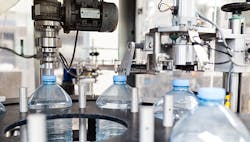A bottle-capping machine is used in industrial production lines to securely apply caps, lids or plugs to bottles and other containers. The type and design of the cap-tightener machine depend on the caps or lid it handles. Some are designed to be flexible enough to securely fix plastic, metallic or glass lids on bottles and containers.
As machines used in the production lines continue to get smarter, five aspects have impacted their control systems and automation.
Also read: As go consumer trends, so goes packaging machinery
1. Smaller but smarter architectural footprints
Smaller and smarter bottle cappers come with advanced features that replace less-efficient manual and semi-automatic capping machines. The previous generation of automatic capping machines was also bulky and expensive.
Automatic capping machines are lighter, cost-effective and more versatile. They can be adjusted easily to suit various bottle types and to cap at faster or slower speeds. The smaller architectural footprints also mean lower energy consumption and smaller real-estate needs.
Additionally, the control architecture is slowly shifting from programmable logic controllers (PLCs) to PC-controlled systems. This shift allows for faster communication and controls, plus it supports more customization, thanks to the many programming languages the PC controller can support.
2. Distributed motion control
In every production line, motion control is necessary to manage how products move from one point to the other. For the Gen 3 capping machines and newer models, motion can easily be distributed to individual devices. This wasn’t the case a decade ago, where motion control was linear.
Some capping systems allow for synchronization with other machines. They communicate with them and can work in unison at a predetermined speed. Coupled with the automation, distributed motion control has made capping and packaging a seamless process.
3. Variable-speed operation
Not so long ago, the speed of production in the industrial sector was limited to a few predetermined levels. This has changed. With a simple push of a button, it’s possible to change the speed at which a capping machine tightens or secures a cap onto a container. This versatility and convenience have been made possible, thanks to variable-speed drives (VSDs).
Speed drives are devices used to control the torque, or force, and speed of an ac motor. By adjusting the motor’s voltage and input frequency, it’s possible to change how fast the capping work is done. These speed drives can be used in mechanical, electric, electronic or even hydraulic applications. Advancements in technology have further made this technology more convenient—for instance, boosting power factor and improving energy efficiency.
4. Clean-in-place technology
Capping machines designed to handle different bottle sizes and types should come fitted with clean-in-place (CIP) technology, which helps to sanitize the capping machine and avoid contamination. It’s common in the food-processing and pharmaceutical-manufacturing industries.
CIP technology is fully automated to minimize human contact, which is considered the primary source of contamination. A bottle capper fitted with this technology will have the filling pipes, vessels and filters cleaned without disassembly. Besides preserving the integrity of the packaged products, CIP technology also saves time and increases productivity. When choosing a capping machine, always select one with CIP technology, which makes it cost-effective in the long run.
5. Packaging line automation
An automatic bottle-capping machine is not really efficient unless it integrates with other packaging machines in the production line. A fully automated packaging line allows for maximum production efficiency. Automation and control systems have made this level of innovation possible. Companies invest in one machine that fills, caps, and labels the bottles ready for packaging.
The type of machine you first introduce into the packaging line will often determine the next one you will buy. Flexible devices and equipment can integrate well with other machine types.
Go with the flow: embrace technology and automation
If you want to buy a capping machine, it only makes sense to embrace these five automation aspects. The most advanced bottle-capping machines will feature the best tech-enabled features. However, they may be a bit costly. Always consider your unique needs, such as product demand and the need for future expansion, before making a buy. If you are on a budget, a Gen 3 bottle capper with all the necessary automation aspects will work for you.
Alejandro Perez is design engineer at Acasi Machinery in Miami. He holds a bachelor’s degree in mechanical engineering from University of Camagüey. Contact him at [email protected].
About the Author
Alejandro Perez
Acasi Machinery

Leaders relevant to this article:

